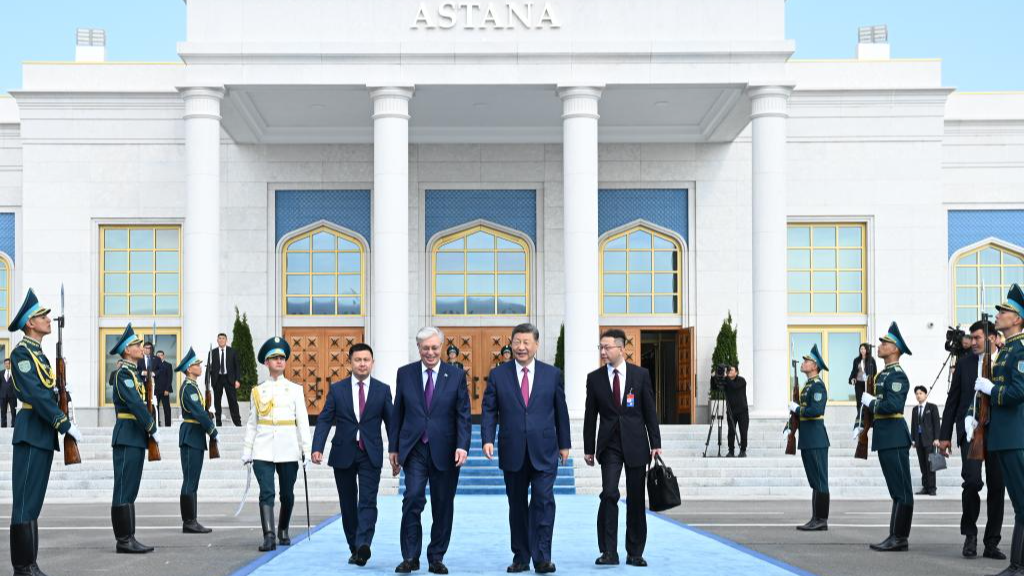By Pan Deng

Chinese President Xi Jinping leaves for Beijing after attending the second China-Central Asia Summit in Astana, Kazakhstan, June 18, 2025. [Photo/Xinhua]
The second China-Central Asia Summit in Astana, Kazakhstan, has solidified a new paradigm in regional cooperation, moving decisively from the aspirational consensus of the inaugural summit in Xi'an, China, in 2023 to a concrete and actionable agenda.
More than a mere diplomatic gathering, the Astana Summit represents the maturation of a relationship grounded in what Chinese President Xi Jinping has termed the "China-Central Asia spirit" – a vision of mutual respect, mutual trust, mutual benefit, and mutual assistance. This spirit now finds tangible expression in a suite of agreements that promise to foster a community of shared future in quiet contrast to the fracturing dynamics seen elsewhere in the world.
As the six nations embark on a "Year of High Quality Cooperation and Development" for 2025-2026, the message from Astana is clear: This is a partnership focused on delivering tangible, long-term prosperity and stability.
From blueprint to building blocks: The summit's outcomes
The Astana Summit was, above all, a summit of substance. The list of outcomes released by the Chinese Foreign Ministry points to a relationship that is both broad in scope and deep in its practical application. The key deliverables include a host of meticulously negotiated agreements covering everything from trade facilitation and industrial investment to agricultural modernization and people-to-people exchanges. This follows a period of robust growth, with trade between China and the five Central Asian states soaring to a record $94 billion in 2024.
At the heart of this burgeoning partnership is the "China-Central Asia spirit." First articulated by Xi, this is a guiding philosophy that has deep roots in the more than two millennia of exchanges along the ancient Silk Road. It emphasizes the sovereign equality of all nations, regardless of size or economic might, and a problem-solving approach based on consultation and consensus. This stands in stark opposition to bloc politics and zero-sum competition.
For Central Asian states, historically the objects of great power rivalry, this approach offers a welcome alternative, enabling them to pursue their own development paths in partnership with a major power that explicitly supports their sovereignty and territorial integrity. The establishment of new cooperation centers for poverty reduction, education exchange, and desertification control underscores the human-centric focus of this partnership, aiming to deliver real benefits to the people of the region.
The Astana Declaration: Deepening the Xi'an vision
If the Astana Declaration is compared with the Xi'an Declaration, it shows a clear evolutionary trajectory. While the Xi'an document laid out a comprehensive blueprint for cooperation, establishing the foundational principles and identifying key areas of engagement, the Astana Declaration is more action-oriented. It operationalizes the vision of Xi'an, translating broad commitments into specific action plans and initiatives.
For instance, where the Xi'an Declaration spoke of expanding economic and trade cooperation, the Astana Declaration commits the parties to upgrading their investment agreement and simplifying trade procedures. It moves beyond the general desire for enhanced connectivity to the practical implementation of projects like the China-Kyrgyzstan-Uzbekistan railway. This evolution is a testament to the efficacy of the China-Central Asia mechanism, which in just two years has progressed from establishing a framework to delivering on its promises.
The formal designation of 2025-2026 as the "Year of High Quality Cooperation and Development" further institutionalizes this focus on practical outcomes, setting a clear timeline and shared objective for all six nations. This emphasis on high-quality development signals a move towards more sustainable, technologically advanced, and environmentally conscious projects under the umbrella of the Belt and Road Initiative, addressing some of the early criticisms of the program and aligning it with the long-term development goals of the Central Asian states.

A truck drives at the Irkeshtam Port, China's westernmost land port, in Xinjiang Uygur Autonomous Region, November 7, 2023. [Photo/Xinhua]
A new regional security architecture
Another significant and far-reaching outcome of the Astana Summit is the signing of the Treaty on Permanent Friendly Neighborliness and Cooperation. The inclusion of the word "permanent" is a powerful statement of strategic intent. It elevates the relationship beyond the realm of transactional diplomacy and codifies a lasting commitment to non-aggression, mutual support, and peaceful resolution of disputes.
In a world beset by geopolitical uncertainty and shifting alliances, this treaty provides a bedrock of stability for the entire region. It is a pioneering initiative in China's neighborhood diplomacy, enshrining the principle of everlasting friendship in international law. The strategic weight of this treaty cannot be overstated, particularly in light of the volatile security landscape in the wider region. While the escalating tensions in the Middle East, particularly between Israel and Iran, cast a long shadow, the leaders in Astana focused on their shared agenda of development.
The logic underpinning the China-Central Asia partnership is that development is the most effective guarantor of peace and stability. By fostering economic growth, creating jobs, and improving livelihoods, the initiatives launched in Astana aim to address the root causes of conflict and instability. A prosperous and interconnected Central Asia is a more resilient Central Asia, better equipped to withstand external shocks.
The Permanent Friendly Neighborliness Treaty, therefore, is not merely a diplomatic document; it is a crucial component of a new, indigenously-led security architecture for the region. It fosters a predictable and stable environment in which long-term development work can proceed unhindered, demonstrating a sophisticated understanding that peace and prosperity are inextricably linked.
A new locus of stability in Eurasia
The Astana Summit has done more than advance a bilateral relationship; it has fortified a new locus of stability and development in the heart of Eurasia. By moving from the foundational consensus of Xi'an to the tangible actions agreed upon in Astana, the China-Central Asia mechanism has proven itself to be both dynamic and effective. The commitment to a "permanent" friendship, underpinned by a detailed roadmap for high-quality development, provides a powerful anchor in an era of global flux.
This is not merely regional diplomacy; it is the construction of a community of shared future, built on the principles of mutual respect and shared prosperity. As this partnership continues to deepen, it will not only determine the trajectory of Central Asia's development but also increasingly serve as an example of an alternative, cooperative approach to international relations, one where stability is pursued through development and security is found in shared interests, not shifting alliances.
The author is a current affairs commentator.

 中文
中文



